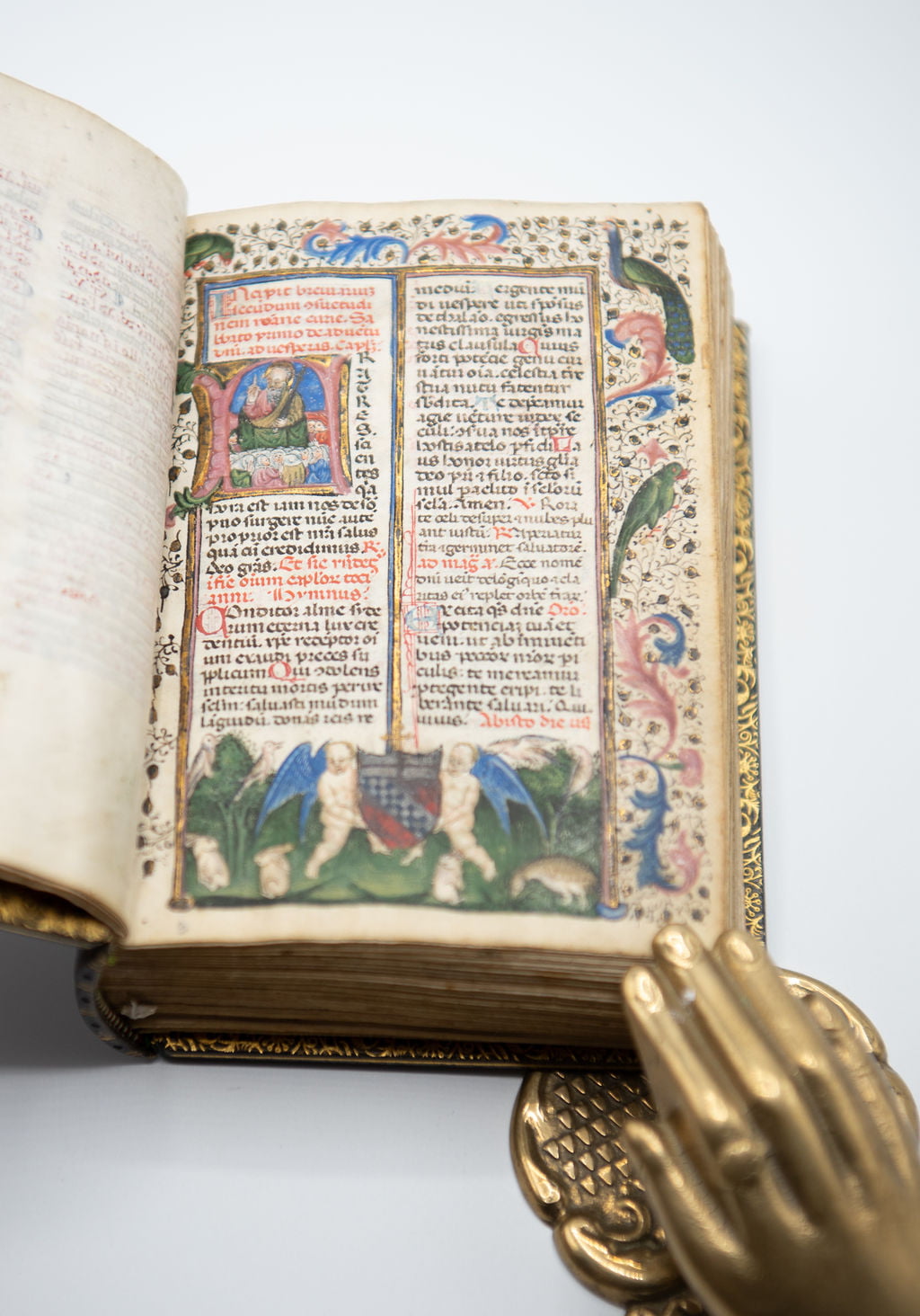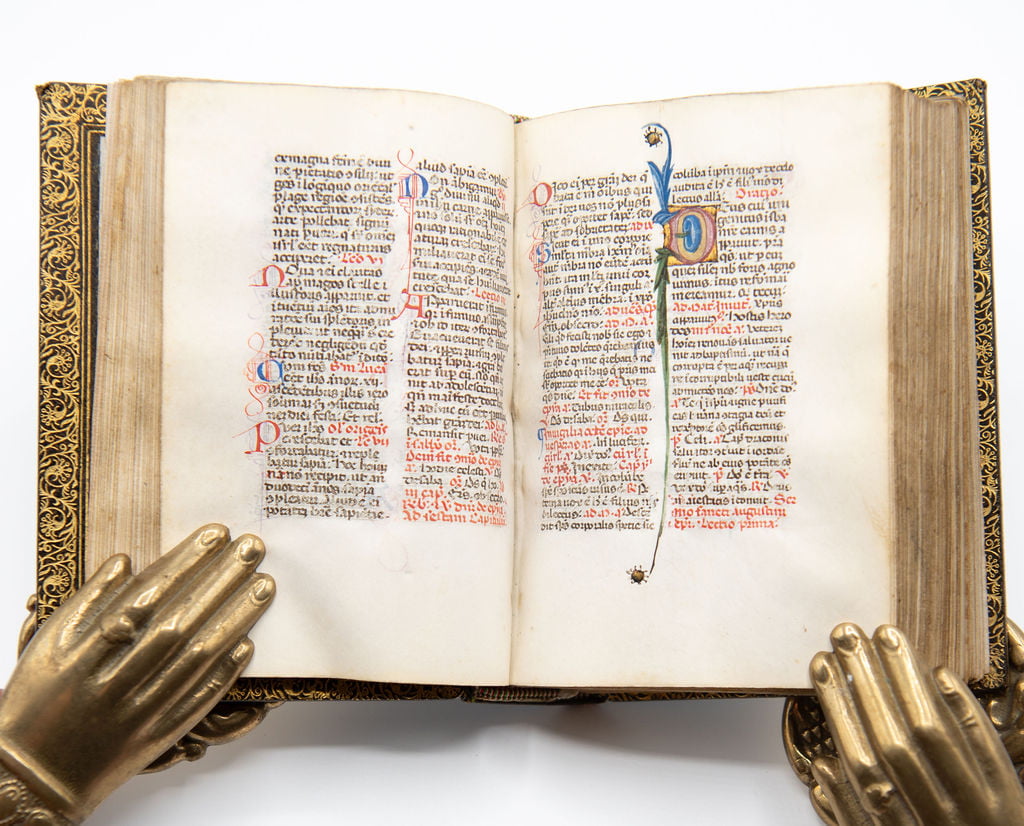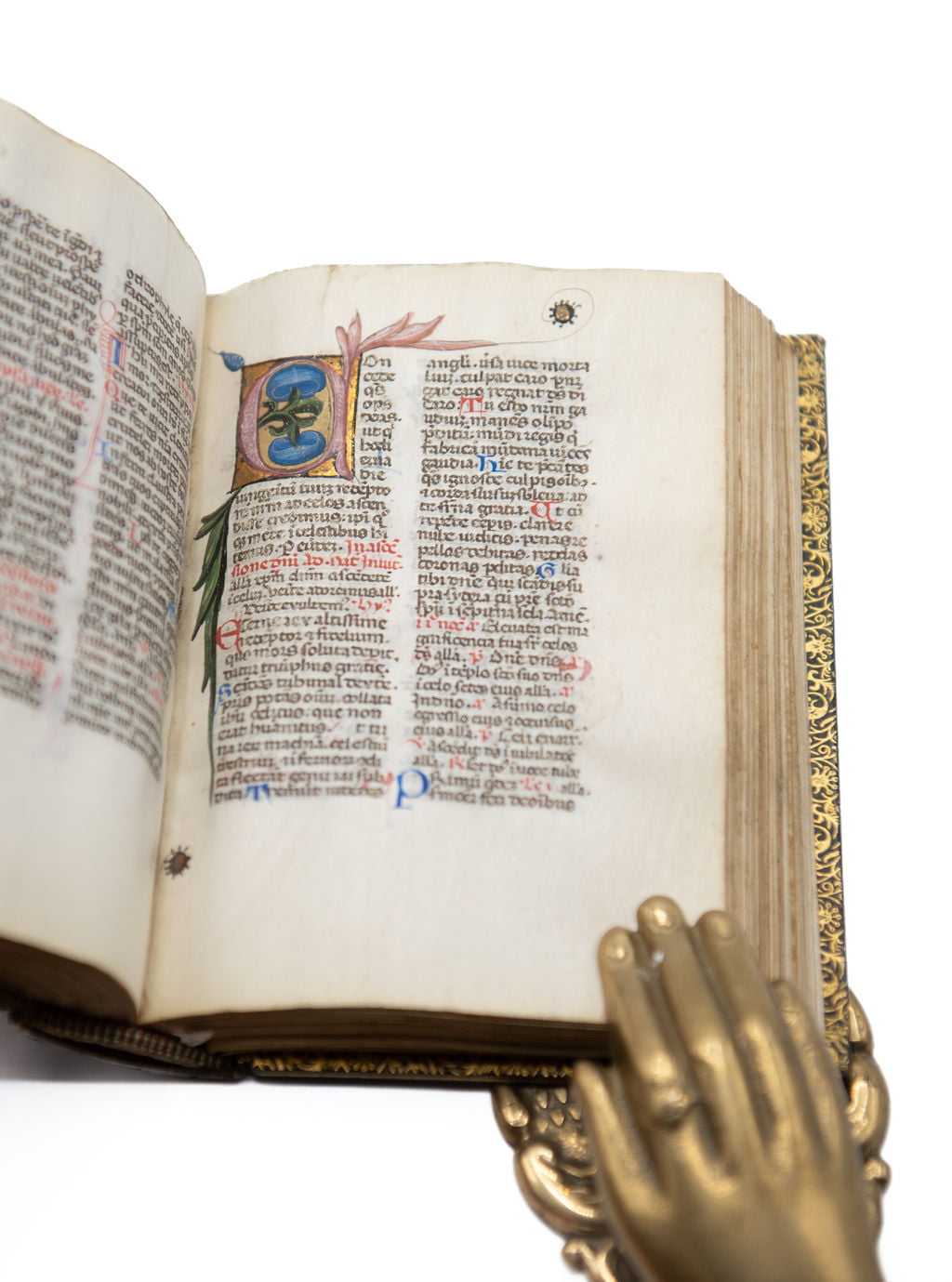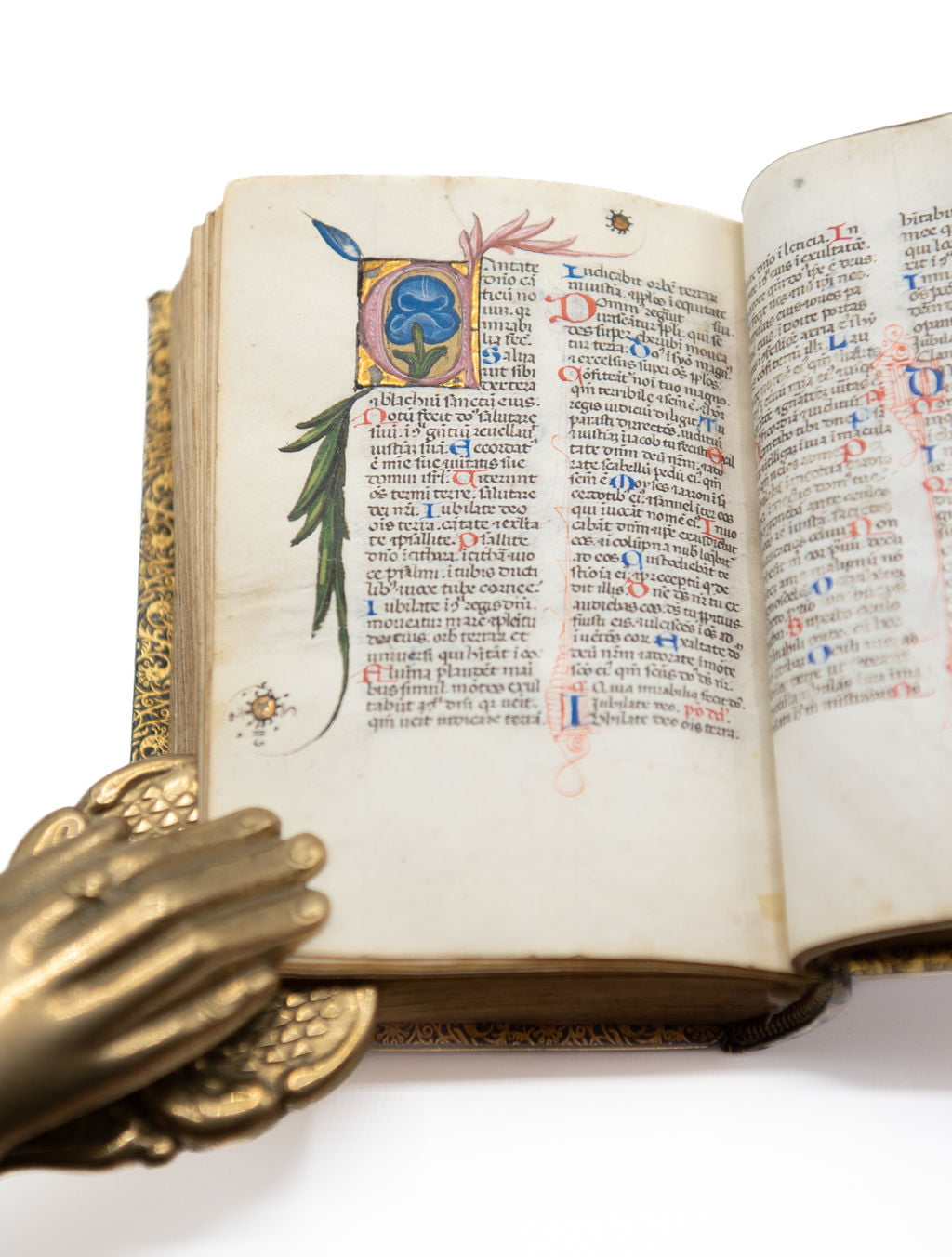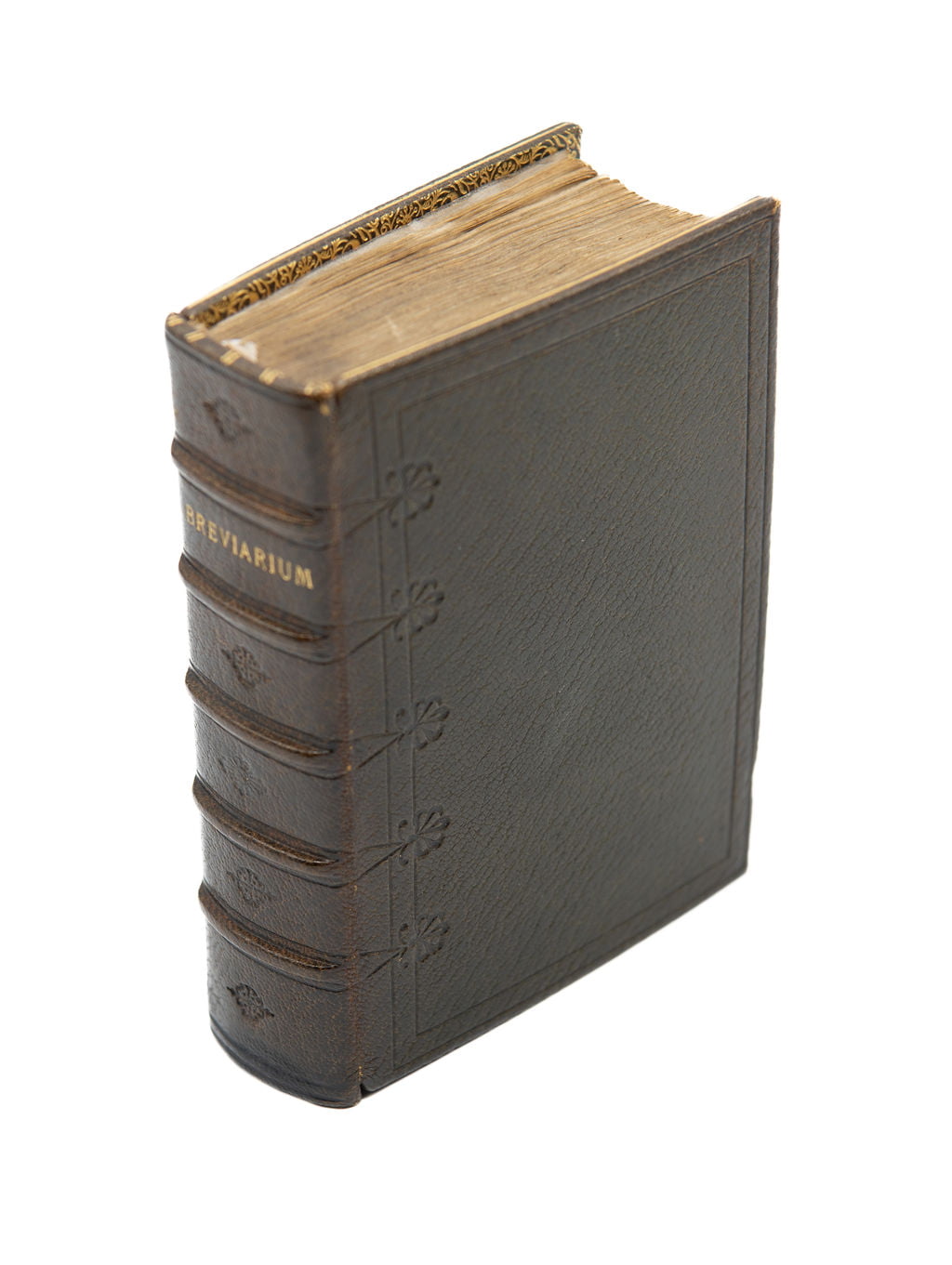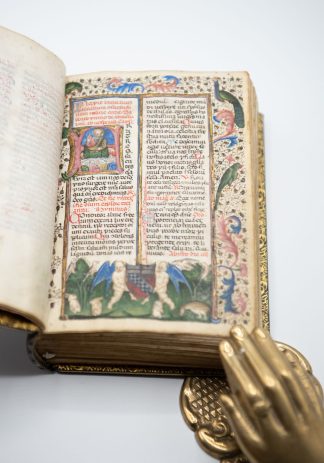PORTABLE BREVIARY AND PSALTER FOR ROMAN USE
FOR THE PRIVATE DEVOTION OF A POPE,THE CYBO BREVIARY
Illuminated manuscript in Latin on vellum
Northern Italy, probably Liguria, (Genoa or Savona), 1447 and third quarter of the 15th century£45,950.00
134 x 94 mm, 272 leaves on parchment: I7 (of I8, first blank excised); II-XII10, XIII8, XIV-XX10 (XX.10 blank); XXI10, XXII8, XXIII-XXVIII10; XXIX2 (blanks), justification 81 x 58 [26-7-25] mm, ruled in lead point for two columns, 30 horizontal lines ruled in light brown ink for 29 lines of text, regular Italian Gothic script [Southern Textualis Rotunda] in red and black by two hands, first on fols 1v-190r, second, smaller, thinner, less compressed and more elegant, on fols 192r-268r, both hands occasionally employing the humanist “d” with straight ascender, catchwords in black or red ink in the lower margin of last verso of quires. Rubrics in red, paragraph marks in blue, and two-line initials in alternating red and blue with contrasting pen-flourishing in purple or red throughout. 19 illuminated initials (4-9 lines high) in pink or blue with white tracery set against a ground of gold with foliate and floral decoration in blue, pink and green with foliate extensions in blue and green, often with a gold bezant at the end. In the Psalter the initials mark the beginning of the eight psalms (ps. 1, 26, 38, 52, 68, 80, 97 and 109) to be recited at Sunday Vespers. One nine-line illuminated initial “B”[eatus] (fol. 192v) in pink with white tracery set against a gold-leaf ground and depicting David at prayer set against a blue ground with white tracery, foliate extension in blue and green with a gold-leaf bezant. 2 illuminated initials and full borders: 1 ten-line initial “F”[ratres] (fol. 8r) in pink with white tracery set against a gold-leaf ground, depicting St Paul with sword preaching to the people, written space outlined by a gold-leaf bar border, including the bas-de-page bearing the coat-of-arms of the Cybo of Genoa supported by two winged putti in a green landscape with trees, rabbits and birds, the outer borders with foliate decoration in blue and pink interspersed with two green parrots, a green peacock and gold-leaf bezants; 1 seven-line illuminated initial “P”[rimo] (fol. 192r) in blue with white tracery set against a gold-leaf ground with floral decoration in pink, blue and green and full-border extensions of foliate design in shades of blue, pink and green with gold-leaf bezants, the Christogram “HIS” in the bas-de-page, inscribed in the blue ground at centre of a radiant sun in gold-leaf. Good quality parchment, in good condition, with large, clean margins, slight crease on first and last leaves (fols 1-6 and 243-270), ink occasionally fading or slightly erased, offprint on fol. 7v. Modern brown morocco binding.
This rare and charming volume includes a Temporal Breviary and Liturgical Psalter, i.e. service books used in the daily offices, both for the use of Rome. The Proprium de tempore (fols 8r-190r) provides the liturgy for the celebration of the Divine Office from the first Sunday of Advent according to the rite of the Roman Curia, with no further specification but for the inclusion in the litany (fols 74v-77r) of Zenobius, bishop of Florence, among the confessors, and of the Franciscan saints Francis, Clare and Elisabeth among monks and virgins respectively. It is dated 12 February 1447 and preceded by a table of rubrics (fols 1v-7r). The Liturgical Psalter (fols 192r-268r) supplies hymns, canticles, antiphones, versicles and responses according to the Cursus Romanus of the liturgy of the Hours and it is datable to the third quarter of the 15th century. The Temporal and the Liturgical Psalter were copied by two different scribes and at different times, with the Psalter probably dating to the early 1460s.
Nevertheless, the pen-flourished decoration of the minor initials and the beautiful illumination of the borders and major initials are consistent throughout the book and seemingly belong to the same decorative campaign, datable to the 1460s or early 1470s. The illumination was executed by an eclectic anonymous artist who was strongly influenced by the style of earlier and contemporary illumination from Lombardy in Northern Italy as suggested by the illuminated borders on fols 8r and 192r and the portrait initials on fols 8r and 192v (see A. De Floriani, “La miniatura in Liguria nella seconda metà del Quattrocento: un bilancio provvisorio”).
A connection with Northern Italy, and more specifically Liguria, is also suggested by the escutcheon in the bas-de-page and the depiction of a peacock in the border of the first page of the Breviary (fol. 8r), respectively identifiable as the arms and the emblem of the Cybos, a patrician family of Genoa. The nature of the text (a breviary for members of regular and secular clergy) and the cross above the shield, indicates an ecclesiastic of high status as the original owner. Two members of the Cybo family were created bishops and cardinals in the second half of the fifteenth century: Cardinal Giovanni Battista Cybo (1432-1492) bishop of Savona (1466-1472) and Molfetta (1472-1484), and his young cousin Cardinal Lorenzo Cybo de Mari (1450/1-1503), archbishop of Benevento (1485-1503). As the cross above the arms shows the single horizontal limb of an episcopal cross, rather than the double traverse of the archiepiscopal one, the owner was Giovanni Battista Cybo before his election to the papacy as Pope Innocent VIII on 29 August 1484.
In November 1466 Giovanni Battista was made bishop of Savona, a town to the west of Genoa in the region of Liguria in Northern Italy; at the time under the government of the Duke of Milan, Galeazzo Maria Sforza. These political circumstances favoured the arrival in Liguria of artists from Lombardy who imported new models and a more sophisticated artistic style to provincial Liguria. It is therefore conceivable that the two texts, the Temporal Breviary and the Liturgical Psalter, were brought together, decorated and assembled in a single volume in Liguria (Savona or Genoa) as a gift to Cybo as Bishop of Savona. Through the depiction of Cybo’s peacock and of the partridge and white rabbits in the margins of the opening of the Temporal Breviary, the decoration of the book seems to bestow upon the bishop a life of splendour, wisdom and knowledge, purity and truth, resurrection and ultimately immortality.
This high quality manuscript for Cybo’s private devotion and therefore after his death probably remained in the possession of his family, whereas books belonging to him as pontiff were kept in the papal library (now the Vatican Library). The volume was certainly in use after the pope’s death as an unprofessional hand added two notes relating to the death of Innocent VIII and the election of his successor Alexander Borgia in August 1492 to fol. 272v. It was possibly passed on to the pope’s cousin Cardinal Lorenzo Cybo de Mari, who had the pope’s tomb in the Vatican basilica completed by the leading painter and sculptor Antonio del Pollaiuolo in 1498 and his body buried in the bronze monument on January 1498. It is worth noting that the pope’s arms on the tomb are identical to those found in this book [see A. Wright, The Pollaiuolo brothers: the arts of Florence and Rome, New Haven, 2005, chapter XIII].
As the book is not listed in the inventory of the books bequeathed by Cardinal Lorenzo to the Cathedral of Benevento (see A. Zaro, “L’Inventario dei libri antichi della Biblioteca Capitolare di Benevento”, Samnium, viii (1935), pp. 5-25, in particular pp. 23-5), it is probable that it was passed on as a prized possession to other members of the Cybo family, including Cardinal Innocenzo Cybo (1491-1550), the grandson of Innocent VIII, appointed as cardinal by his uncle Leo X in 1513, and Cardinals Alderano (1613-1700) and Camillo (1681-1743).
In stock


